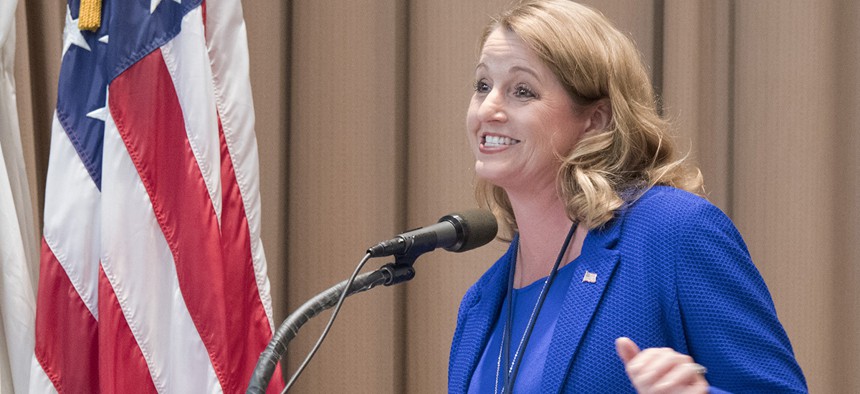Federal CIO: Modernization Board Wants More Proposals and Here’s What It Needs

Suzette Kent, Federal CIO GSA
Suzette Kent shares just what kind of ideas the board is looking for.
The Technology Modernization Fund Board has moved four proposals to the penultimate stage but that doesn’t mean the proposal process is closed for business. The board wants more proposals—specifically, those that could have broad impact across government.
Suzette Kent, federal chief information officer and chair of the board, said board members are looking to move quickly on the proposals before them but want agencies to know they want a constant flow of new ideas coming in.
“We’re still taking in new proposals,” Kent stressed during an interview with Nextgov. Those projects will be taken up on a rolling basis, she explained. “Since we’re just now moving to looking at phase two proposals, we will accommodate those as quickly as we can and then we’ll fit in new business around that.”
While the first four proposals—which have not yet been identified—are furthest along in the process, they won’t be eating up all of the board’s funding for 2018.
Those initial proposals include information on the idea, its intended impact on the agency and broader government efforts and a high-level overview of the timeline and expected outcomes. The board considered nine such proposals, whittling the field down to four to move to the second phase.
In the second phase, project managers will have to submit more detailed plans, including cost structure, repayment plans and specific milestones with a schedule to meet those metrics. Those plans will be presented—in person—to the full board, which will then decide whether to move the project forward to funding.
“The board has $100 million to award; those four [initial projects] do not represent the totality of our money,” Kent said. “That’s why we’re asking all agencies to continue to submit good ideas, whether they’re agencies who have already submitted proposals or agencies who haven’t.”
And after this initial push, future projects could move through the process faster, she said.
“What the board will do is talk to those teams, hear the presentations and then make some decisions on whether we immediately want to move into an award or if there are some other things we want to ask that team to continue to work on,” she said.
The proposals currently under consideration run the gamut from small to large, mission-specific to agencywide.
“We have seen everything from less than $1 million to things over $30 million. We’ve seen a full range,” Kent said. “Which is also a value of the board because we’re looking at all those simultaneously but we’re weighing the objectives of what the lawmakers asked.”
She noted the legislation creating the fund—the Modernizing Government Technology Act—had very specific areas for the board to focus its efforts. Those include upgrading legacy systems, moving to cloud email and an emphasis on shared services, among others.
“We’ve seen good numbers of some of those,” she said. What the board needs more of are projects that have broader impact across the government. For example, if an agency develops a process that can be repeated by others or is building a thing that could be shared.
Agencies should aim to meet the criteria, clearly state the project’s outcome and how it will be achieved. “That’s what gets us excited,” she said.
Along with impact and reusability, the board is also looking for “maturity of thinking,” particularly around acquisition strategy. The best proposals are those that follow well-tread paths to modernization forged by other agencies or include a comprehensive acquisition strategy that demonstrates thought and experience.
The board is also giving more credence to projects using commercial products, rather than being built in-house. The key, Kent said, is moving quickly and showing results.
“We don’t want to award money and then wait two years before we can start,” she said, noting the General Services Administration is a close partner and has members on the board to assist with the acquisition strategy. “That’s part of the back-and-forth: to make sure that the project team is evolved enough in their thinking on that and that they have a well-thought-out acquisition strategy.”






